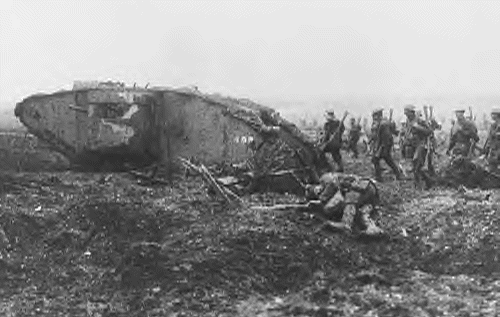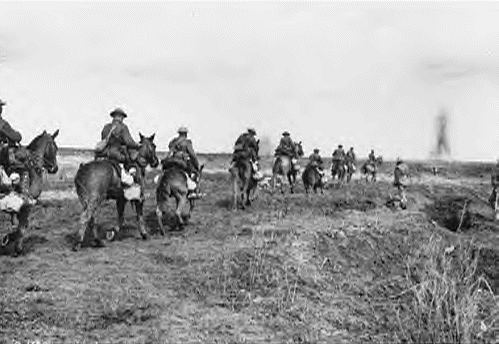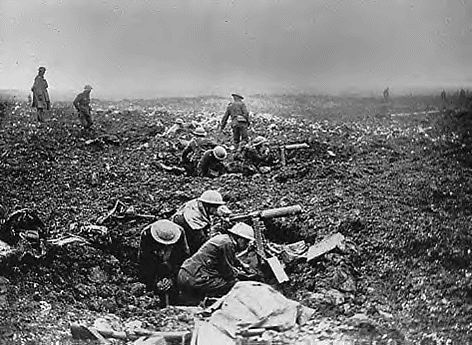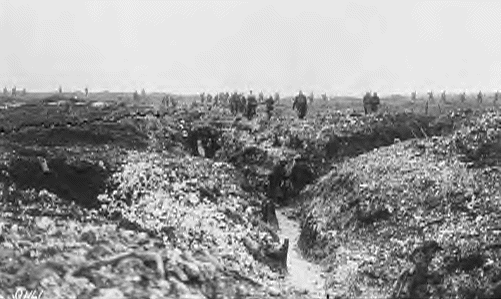9 - 12 April 1917
On the Western Front, the British Third Army is assigned the task of breaking through German defences at Arras, while the four divisions of the Canadian Corps secure the British flank by capturing Vimy Ridge. (Both operations are intended to draw German reserves away from the areas, further south, where General Nivelle's French forces will launch the primary offensive). When Nivelle's attack is complete, General Haig will transfer his forces north to Ypres for the main British blow of the year: this offensive aims to liberate the whole occupied Belgian coast, by breaking through the enemy lines at the small Flanders village of Passchendaele.
The Canadians' goal in the offensive of Spring 1917 - Vimy Ridge - has been held by the Germans since October 1914. They have used the intervening period to construct elaborate fortifications, adding to the Ridge's natural defences. (The Ridge dominates the surrounding Douai Plain, and is a natural vantage point for launching artillery strikes on the Allied lines below). By the end of 1916, the German defenders have constructed three main defensive lines, consisting of a maze of trenches, concrete machine-gun strong points, and deep dug-outs, all linked by tunnels and underground chambers that can each shelter entire battalions from Allied shells. In view of this, it is not surprising that previous unsuccessful attempts to recapture the Ridge have cost almost 200,000 lives.
In the late autumn of 1916, the Canadians move north from the Somme to relieve British troops opposite the western slopes of Vimy Ridge. Here, they began a scrupulously-detailed training programme which the commanders of the Canadian Corps believe will ensure success where previous assaults have failed. This is to be a "set-piece" battle, behind a perfectly timed rolling barrage: all of which demands thorough rehearsal of the troops and the massing of enormous quantities of guns, ammunition and stores. Gus Sivertz of the 2nd Canadian Mounted Rifles later described being taken behind the lines to the village of Rimbert, to train for the attack. "Here, we started a schedule of the most intensive training, mainly over taped trenches in an area that simulated the slopes of Vimy on a small scale. Every few days we were visited by the Big Brass who watched as we practised attacking at a slow walking pace...while officers rode ahead carrying little flags that moved at a speed that they hoped the barrage would move. When Sir Julian Byng, the Canadian Corps Commander came up, there wasn't the slightest doubt about what was in the offing".
Because of the vast preparations needed, the Germans too are well aware of what is being planned - the only real secret is the exact date of the attack. A German officer, captured by a Canadian raiding party tells one of his interrogators, George Hancock of Princess Patricia's Canadian Light Infantry: "We know you're going to attack Vimy Ridge. We know all about your plans. You might get to the top of Vimy Ridge, but I'll tell you this, you'll be able to take all Canadians back to Canada in a row boat that get there".
Because two Hills - Hill 145 and Hill 135 - dominate the crest of the Ridge, it is decided that the infantry attack should be divided into two phases. The main attack will consist of the Southern Assault, to take and hold Hills 145 and 135, together with the ground they command. If this Southern Assault is successful, then a separate Northern Assault will be launched against "The Pimple", an isolated knoll at the far north of the Ridge, which has been strengthened by concrete pill-boxes bristling with machineguns. The Woods' eleventh son, Peter Percy Wood, is situated with the 46th Canadian Battalion at the far north of the Canadian line; in the Souchez Sector, opposite Givenchy-en-Gohelle. The 46th will be held in reserve throughout the southern part of the offensive and, if and when Hills 135 and 145 are taken, they will storm the Pimple, along with the 44th and 50th Battalions.
The Infantry attack is preceded by a powerful artillery bombardment, designed to destroy the heavy gun and other fortified positions on the Ridge. The bombardment begins in mid-March 1917, and is carried out by nearly 1,000 artillery pieces: which breaks down to one heavy gun to every twenty yards of front, one field gun for every ten yards. Throughout the three weeks of the bombardment, Michael Volkheimer was serving with Bavarian Reserve Infantry Regiment No.3 near Thelus in the central part of the Ridge, and he recalled: "After several days of uninterrupted barrage from artillery of all calibres, the enemy finally levelled our defensive positions, the 1st Line, 2nd Line, 3rd Line, and all the connecting trenches as well. We sought shelter in the dugouts which were deep below the ground, but soon the entrances were blown in and many German soldiers buried alive".
The artillery briefly falls quiet on the morning of 9 April, as the Canadian Infantry moves forward to their starting positions in No-Man's-Land, but "at five thirty am precisely the whole atmosphere was rent by screaming shells passing overhead, every gun seemingly having been fired as if by clockwork. The German frontline was erupting along its entire length and seemed to be enveloped in sheet lightning" (Sgt David Layton, 15th Royal Warwickshires). This is the beginning of the rolling barrage, aimed to wipe out defensive positions immediately ahead of the Canadian advance. Because the Canadians are heavily laden, and crossing a No-Mans-Land of sticky mud and impassable craters, the barrage moves ahead of the infantry at a deliberately slow pace that the foot soldiers could keep up with - three minutes for each one hundred yards. Gus Sivertz later recalls that once the barrage began, "I looked ahead and saw the German front line crashing into pieces...We didn't dare lift our heads, knowing that the barrage was to come flat over us and then lift in three minutes...It was perhaps the most perfect barrage of the war, as it was so perfectly synchronised. Then, suddenly, it jumped a hundred yards and we were away"...
In fact, the artillery assault of the previous weeks, and the synchronised bombardment of 9th April, do their jobs most effectively, allowing the first part of the Southern Assault to proceed like clockwork. "We felt so safe with that rolling barrage in front," recalled H Campbell of the 14th Battalion. "You could see the thing beating. It was just like a lawnmower, you know, when you're cutting grass". By the end of the first day of the attack on Vimy Ridge, all of the southern objectives have been taken, with the exception of Hill 145, which falls to elements of the 4th Canadian Division early the next morning.


Credit:
NAC, #PA-1111


NAC, #PA-1017
NAC, #PA-1129
The success at Vimy Ridge does not lead to the hoped-for decisive breakthrough on the Western Front, but it is the greatest Allied victory in the War thus far, and is achieved with comparitively low casualties on the Allied side: about 3,600 dead and 7,000 wounded. (When the War ends, and the Canadian government is seeking a site for its national memorial to the dead of the Great War, it selects Vimy Ridge, where the Canadian Corps enjoyed its greatest triumph. Today the land around Vimy, including the Ridge itself, has been given by France to Canada in perpetuity, in recognition of Canada's contribution to the First World War. The Vimy Memorial which now stands there is Canada's national memorial not only to those who died at Vimy, but to all 60,000 Canadians who lost their lives).
Percy Wood emerges unscathed from the victory at Vimy Ridge, but is killed in action three weeks later, as the 46th Battalion consolidates its hold on the land won in the Vimy offensive. Percy's burial place is unknown, and he is commemorated by name on the Vimy Memorial.